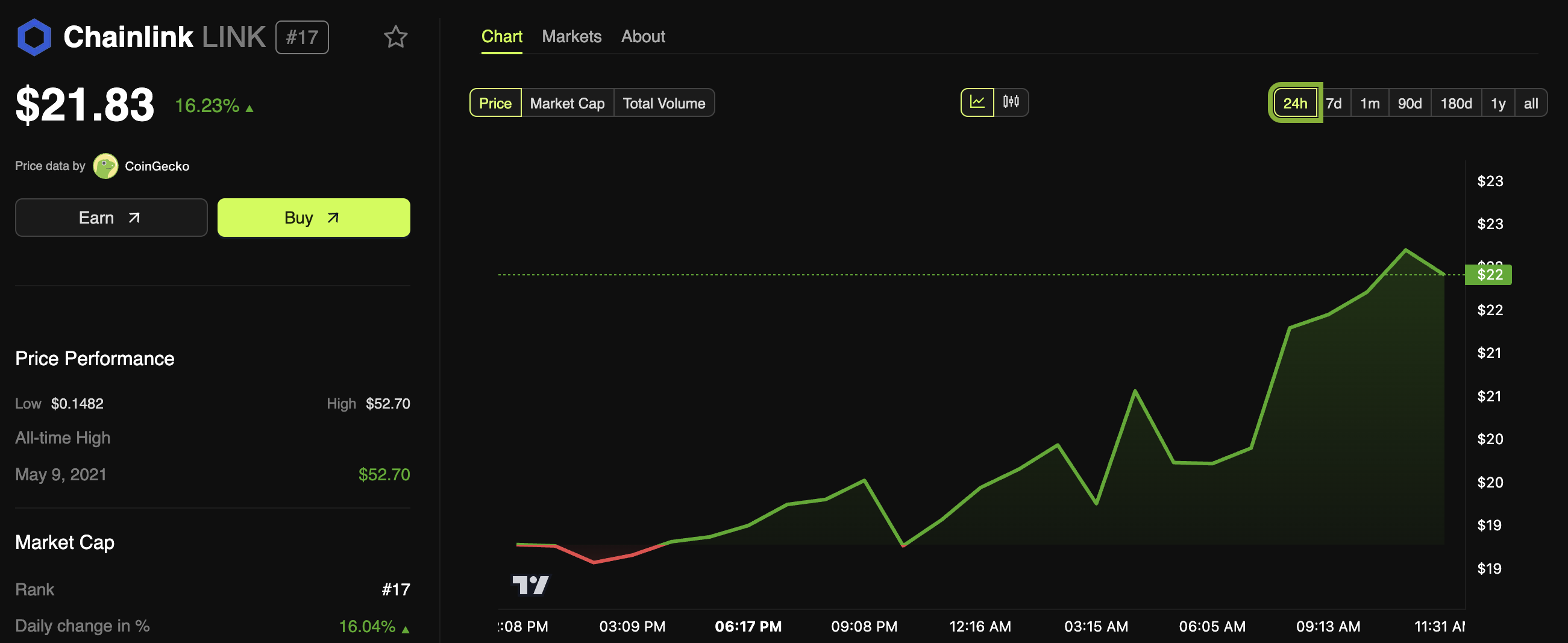| COINOTAG recommends • Exchange signup |
| 💹 Trade with pro tools |
| Fast execution, robust charts, clean risk controls. |
| 👉 Open account → |
| COINOTAG recommends • Exchange signup |
| 🚀 Smooth orders, clear control |
| Advanced order types and market depth in one view. |
| 👉 Create account → |
| COINOTAG recommends • Exchange signup |
| 📈 Clarity in volatile markets |
| Plan entries & exits, manage positions with discipline. |
| 👉 Sign up → |
| COINOTAG recommends • Exchange signup |
| ⚡ Speed, depth, reliability |
| Execute confidently when timing matters. |
| 👉 Open account → |
| COINOTAG recommends • Exchange signup |
| 🧭 A focused workflow for traders |
| Alerts, watchlists, and a repeatable process. |
| 👉 Get started → |
| COINOTAG recommends • Exchange signup |
| ✅ Data‑driven decisions |
| Focus on process—not noise. |
| 👉 Sign up → |
-
21x has strategically partnered with Chainlink to integrate the Cross-Chain Interoperability Protocol (CCIP), becoming the first EU-regulated blockchain financial market infrastructure.
-
The evolving MiCA regulations are significantly reshaping the European crypto landscape, with 21x poised to capitalize on opportunities in tokenized money and securities.
-
According to a Chainlink spokesperson, “We’re excited to partner with 21X and help foster the adoption of regulated blockchain-based markets across Europe,” highlighting the partnership’s importance.
This article discusses the strategic partnership between 21x and Chainlink, focusing on the impact of MiCA regulations on the European crypto market.
Chainlink and 21x: A Transformative Partnership
In a significant development, 21x announced a partnership with Chainlink, a leading player in blockchain technology. This collaboration aims to integrate 21x’s platform onto the Cross-Chain Interoperability Protocol (CCIP), a blockchain standard gaining traction globally. This groundbreaking announcement positions 21x as “the first EU-regulated financial market infrastructure” to deliver services in tokenized money and securities.
“We’re excited to partner with 21X and help foster the adoption of regulated blockchain-based markets across Europe. By leveraging the Chainlink standard, 21X will ensure its matching and settlement system is underpinned by highly accurate and reliable market data,” stated Angie Walker, Global Head of Banking and Capital Markets at Chainlink Labs.
The shifting regulatory landscape in the EU, particularly due to the Markets in Crypto Assets (MiCA) law, has created a ripple effect in European markets recently. Notably, Tether, a leading stablecoin issuer, withdrew from EU operations, citing compliance issues with MiCA. In contrast, companies like Revolut are leveraging these changes to expand their operations.
| COINOTAG recommends • Professional traders group |
| 💎 Join a professional trading community |
| Work with senior traders, research‑backed setups, and risk‑first frameworks. |
| 👉 Join the group → |
| COINOTAG recommends • Professional traders group |
| 📊 Transparent performance, real process |
| Spot strategies with documented months of triple‑digit runs during strong trends; futures plans use defined R:R and sizing. |
| 👉 Get access → |
| COINOTAG recommends • Professional traders group |
| 🧭 Research → Plan → Execute |
| Daily levels, watchlists, and post‑trade reviews to build consistency. |
| 👉 Join now → |
| COINOTAG recommends • Professional traders group |
| 🛡️ Risk comes first |
| Sizing methods, invalidation rules, and R‑multiples baked into every plan. |
| 👉 Start today → |
| COINOTAG recommends • Professional traders group |
| 🧠 Learn the “why” behind each trade |
| Live breakdowns, playbooks, and framework‑first education. |
| 👉 Join the group → |
| COINOTAG recommends • Professional traders group |
| 🚀 Insider • APEX • INNER CIRCLE |
| Choose the depth you need—tools, coaching, and member rooms. |
| 👉 Explore tiers → |
Unlike others, 21x appears poised to take advantage of these regulatory changes. Through its collaboration with Chainlink, 21x plans to provide order matching, trading, settlement, and registry services, all while navigating the regulatory environment effectively. Notably, Germany’s Federal Financial Supervisory Authority (BaFin) will oversee the launch, enhancing the initiative’s credibility.

Chainlink (LINK) Price Performance. Source: COINOTAG
| COINOTAG recommends • Exchange signup |
| 📈 Clear interface, precise orders |
| Sharp entries & exits with actionable alerts. |
| 👉 Create free account → |
| COINOTAG recommends • Exchange signup |
| 🧠 Smarter tools. Better decisions. |
| Depth analytics and risk features in one view. |
| 👉 Sign up → |
| COINOTAG recommends • Exchange signup |
| 🎯 Take control of entries & exits |
| Set alerts, define stops, execute consistently. |
| 👉 Open account → |
| COINOTAG recommends • Exchange signup |
| 🛠️ From idea to execution |
| Turn setups into plans with practical order types. |
| 👉 Join now → |
| COINOTAG recommends • Exchange signup |
| 📋 Trade your plan |
| Watchlists and routing that support focus. |
| 👉 Get started → |
| COINOTAG recommends • Exchange signup |
| 📊 Precision without the noise |
| Data‑first workflows for active traders. |
| 👉 Sign up → |
Chainlink stands to gain from this high-profile collaboration, particularly as its LINK token experiences upward momentum in the market. Following the announcement, LINK’s price has shown resilience, although the direct correlation with the partnership remains speculative at this stage. Meanwhile, Chainlink has engaged in various partnerships that incorporate CCIP integration, including a recent collaboration with Brazil’s Central Bank, further solidifying its market position.
The Regulatory Landscape and Its Implications
As regulation continues to evolve within the EU, 21x’s proactive approach in aligning with compliance mandates illustrates an innovative strategy to thrive in the blockchain sector. The launch of MiCA regulations aims to increase transparency and provide a framework that protects investors, which has been essential for the healthy growth of the crypto market.
| COINOTAG recommends • Traders club |
| ⚡ Futures with discipline |
| Defined R:R, pre‑set invalidation, execution checklists. |
| 👉 Join the club → |
| COINOTAG recommends • Traders club |
| 🎯 Spot strategies that compound |
| Momentum & accumulation frameworks managed with clear risk. |
| 👉 Get access → |
| COINOTAG recommends • Traders club |
| 🏛️ APEX tier for serious traders |
| Deep dives, analyst Q&A, and accountability sprints. |
| 👉 Explore APEX → |
| COINOTAG recommends • Traders club |
| 📈 Real‑time market structure |
| Key levels, liquidity zones, and actionable context. |
| 👉 Join now → |
| COINOTAG recommends • Traders club |
| 🔔 Smart alerts, not noise |
| Context‑rich notifications tied to plans and risk—never hype. |
| 👉 Get access → |
| COINOTAG recommends • Traders club |
| 🤝 Peer review & coaching |
| Hands‑on feedback that sharpens execution and risk control. |
| 👉 Join the club → |
Moreover, the successful implementation of CCIP by 21x could set a precedent for other market players, promoting a standardized approach to blockchain interoperability. This shift could lead to a more integrated European financial system, enhancing efficiency and accessibility for both retail and institutional investors.
Conclusion
In summary, the partnership between 21x and Chainlink marks a pivotal moment in the evolution of the European crypto market. With the backing of regulatory oversight and the integration of advanced blockchain technology, this collaboration not only opens new avenues for growth but also reinforces the commitment to compliance in an unpredictable landscape. The future outlook appears promising for 21x as it seeks to define its niche in the tokenized economy while also potentially influencing the broader regulatory environment.
| COINOTAG recommends • Members‑only research |
| 📌 Curated setups, clearly explained |
| Entry, invalidation, targets, and R:R defined before execution. |
| 👉 Get access → |
| COINOTAG recommends • Members‑only research |
| 🧠 Data‑led decision making |
| Technical + flow + context synthesized into actionable plans. |
| 👉 Join now → |
| COINOTAG recommends • Members‑only research |
| 🧱 Consistency over hype |
| Repeatable rules, realistic expectations, and a calmer mindset. |
| 👉 Get access → |
| COINOTAG recommends • Members‑only research |
| 🕒 Patience is an edge |
| Wait for confirmation and manage risk with checklists. |
| 👉 Join now → |
| COINOTAG recommends • Members‑only research |
| 💼 Professional mentorship |
| Guidance from seasoned traders and structured feedback loops. |
| 👉 Get access → |
| COINOTAG recommends • Members‑only research |
| 🧮 Track • Review • Improve |
| Documented PnL tracking and post‑mortems to accelerate learning. |
| 👉 Join now → |








